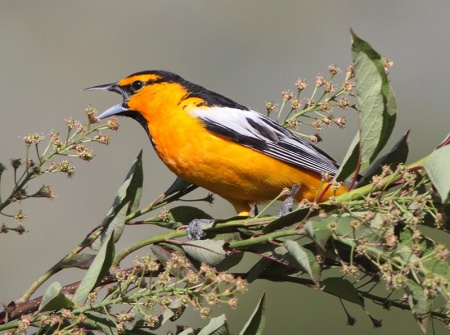- Icterus bullockii
Identification
17-19cm. Male - deep orange, black wings, back, and tail tips, white wing-patches, black caps, black lines through each eye, and black throat patches. Female - grey-brown upper parts, yellow-whitish underneath, 2 white wing-bars on each side. First-year males can be distinguished from females by their black throats and eye-lines.
Distribution
Breeds from southern British Columbia, southern Saskatchewan, Montana, and southwestern North Dakota south to western Texas and northern Mexico. Winters in Mexico south to Costa Rica. Accidental vagrant in the eastern United States and Venezuela.
Taxonomy
The Bullock's Oriole was once combined with the eastern counterpart Baltimore Oriole as a single species, the Northern Oriole, because they began to interbreed on the Great Plains, when the two forms extended their ranges and met. Despite the differences in their appearance, they interbred, producing hybrids with intermediate patterns.
Polytypic. Consists of two subspecies.
Habitat
Open deciduous woods.
Behaviour
The diet includes insects, berries and nectar.
The nest, located in a tree, is a pendulous basket, made from hair, twine, grass, and wool, lined with plant-down, hair, or feathers and suspended from a thin branch, overhanging over water. 4 to 5 eggs are laid and incubated by the female for about 11 days; the young fledge about 14 days later.
References
Birdweb





